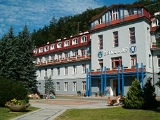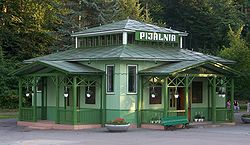
Rymanów Zdrój
Encyclopedia

Destination spa
A destination spa is a short term residential/lodging facility with the primary purpose of providing individual services for spa-goers to develop healthy habits. Historically many such spas were developed at the location of natural hot springs or sources of mineral waters...
in southern Poland
Poland
Poland , officially the Republic of Poland , is a country in Central Europe bordered by Germany to the west; the Czech Republic and Slovakia to the south; Ukraine, Belarus and Lithuania to the east; and the Baltic Sea and Kaliningrad Oblast, a Russian exclave, to the north...
, in Subcarpathian Voivodeship
Subcarpathian Voivodeship
Podkarpackie Voivodeship , or Subcarpathian Voivodeship, is a voivodeship, or province, in extreme-southeastern Poland. Its administrative capital and largest city is Rzeszów...
, in Krosno County
Krosno County
Krosno County is a unit of territorial administration and local government in Subcarpathian Voivodeship, south-eastern Poland, on the Slovak border. It came into being on January 1, 1999, as a result of the Polish local government reforms passed in 1998...
.
Location
Rymanów-Zdrój lies 4 km south of the town RymanówRymanów
Rymanów is a town of 3,585 inhabitants . in Poland's Subcarpathian Voivodeship. It is a capital of a separate commune within the powiat of Krosno...
, in the valley of the river Tabor surrounded by low mountains. It is located in the heartland of the Doły (Pits), and its average altitude is 430 metres above sea level, although there are some hills located within the confines of the city.
History
The source of mineral water was discovered in 1876. The popularity of the near-by spa Iwonicz ZdrójIwonicz Zdrój
Iwonicz-Zdrój . It is located in the heartland of the Doły , and its average altitude is 410 metres above sea level, although there are some hills located within the confines of the city....
caused the owners of the Rymanów estate, Anna and Stanisław Potocki to look for similar springs in the river valley. A chemist, Tytus Sławik, who was staying with them, analyzed the water in a spring and found a high concentration of iodine
Iodine
Iodine is a chemical element with the symbol I and atomic number 53. The name is pronounced , , or . The name is from the , meaning violet or purple, due to the color of elemental iodine vapor....
and iron
Iron
Iron is a chemical element with the symbol Fe and atomic number 26. It is a metal in the first transition series. It is the most common element forming the planet Earth as a whole, forming much of Earth's outer and inner core. It is the fourth most common element in the Earth's crust...
. In 1877 prof. dr Wesselshy, a Viennese chemist, confirmed the initial analysis. Shortly the first boarding houses were built and pipes installed to bring the water from the spring to them.
In 1882 the new spa received a silver medal at an exhibition in Cracow. From that moment the spa expanded rapidly. A children's sanatorium was built in 1885, and a spa pavilion in 1885. The resort became popular with the rising middle class of Lwów, the capital of the Galicia province in Austrian occupied Poland. Many private, ornate villas were constructed.
During World War I
World War I
World War I , which was predominantly called the World War or the Great War from its occurrence until 1939, and the First World War or World War I thereafter, was a major war centred in Europe that began on 28 July 1914 and lasted until 11 November 1918...
the front lines moved through Rymanów three times and the spa suffered severe damage. It was restored and reopened in 1926 and many new villas and installations were built. In the late 1930s up to 5,000 people visited the spa annually.
World War II
World War II
World War II, or the Second World War , was a global conflict lasting from 1939 to 1945, involving most of the world's nations—including all of the great powers—eventually forming two opposing military alliances: the Allies and the Axis...
the spa was almost totally destroyed. After the war, it was rebuilt as a children's sanatorium. In 1965 a new sanatorium was built for adults with 120 beds. In 1980 a plant was built for the bottling of the water and soft drinks. In 1986, on the 120th anniversary of the original founding, the spa was set up a separate community Rymanów Zdrój within area of 1525 ha. (4060 acres). Once more it became a resort. There are several marked hiking trails leading into the surrounding mountains
Famous visitors
During the pre-1914 years, and also 1926-1939, Rymanów Zdrój was frequented by many famous people, including:- Prince Albrecht - uncle of Emperor Franz Joseph,
- Stanisław Wyspiański - poet,
- Ludomir RóżyckiLudomir RozyckiLudomir Różycki was a Polish composer and conductor. He was, with Mieczysław Karłowicz, Karol Szymanowski and Grzegorz Fitelberg, a member of the group of composers known as Young Poland, the intention of which was to invigorate the musical culture of their generation in their mother country.He...
- composer, - Kazimierz Przerwa-TetmajerKazimierz Przerwa-TetmajerKazimierz Przerwa-Tetmajer was a Polish poet, novelist, playwright, journalist and writer. He was a member of the Young Poland movement.-Life:...
- poet and writer, - Mieczysław Fogg - cabaret singer performed here in the 1930s
Hiking trails
- European walking route E8European walking route E8The E8 European long distance path or E8 path is one of the European long-distance paths, leading 4700km across Europe, from Cork in Ireland to Istanbul in Turkey....
- PrešovPrešovPrešov Historically, the city has been known in German as Eperies , Eperjes in Hungarian, Fragopolis in Latin, Preszów in Polish, Peryeshis in Romany, Пряшев in Russian and Пряшів in Rusyn and Ukrainian.-Characteristics:The city is a showcase of Baroque, Rococo and Gothic...
- Miháľov - KurimkaKurimkaKurimka is a village and municipality in Svidník District in the Prešov Region of north-eastern Slovakia.-Geography:The municipality lies at an altitude of 329 metres and covers an area of 12.460 km²...
- DuklaDuklaDukla ; , Duklya] is a town and an eponymous municipality in southeastern Poland, in the Subcarpathian Voivodship. The town is populated by 2,127 people . while the total population of the commune containing the town and the villages surrounding it is 16,640...
- Iwonicz-Zdrój – Rymanów-Zdrój - Puławy – TokarniaTokarnia (peak)Takarnia is a peak in the Bukowica Range in southern Poland. Its height is 778 meters.The southern part is a steep rocky wall, while the other side consist of less steep rocky fields...
(778 m) – Kamień (717 m) – KomańczaKomanczaKomańcza is a village in the Sanok County, in the Subcarpathian Voivodeship of south-eastern Poland. It is situated in the Bukowsko Upland mountains, located near the towns of Medzilaborce and Palota .-History:...
- CisnaCisnaCisna is the main village of the Gmina Cisna in the Lesko County, in the Subcarpathian Voivodeship of south-eastern Poland. It lies in the Solinka valley in between the Bieszczady mountains.-History:...
- Ustrzyki GórneUstrzyki GórneUstrzyki Górne is a village in the administrative district of Gmina Lutowiska, within Bieszczady County, Subcarpathian Voivodeship, in south-eastern Poland, close to the border with Ukraine. It lies approximately south of Lutowiska, south of Ustrzyki Dolne, and south-east of the regional...
- TarnicaTarnicaTarnica is a peak in the Bieszczady Mountains in southern Poland. Its height is 1,346 meters. It is one of the Polish Crown Peaks.The summit towers 500 meter above the Wołosatka Valley. It can be easily told apart from its neighbours by its distinctive shape. The mountain has two separate...
- Wołosate.
- Prešov

